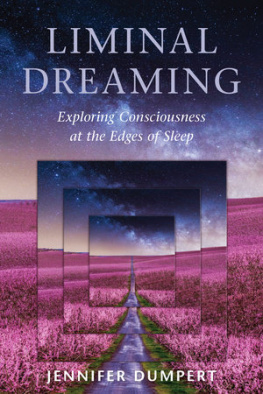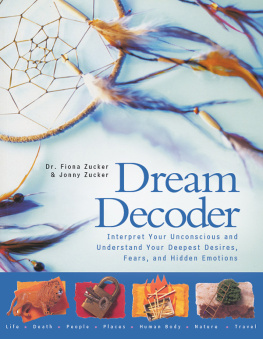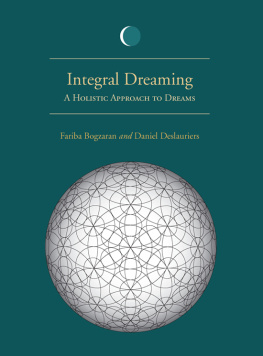


C OPYRIGHT 1996, 2001 BY J ILL M ELLICK
All Rights Reserved. No part of this book may be used or reproduced in any manner whatsoever without written permission, except in the case of brief quotations in critical articles or reviews. For information, contact: Conari Press, 2550 Ninth Street, Suite 101, Berkeley, CA 94710-2551.
Portions of this book were previously published under the tide The Natural Artistry of Dreams.
Conari Press books are distributed by Publishers Group West.
ISBN: 1-57324-574-7
Cover Photography: Photonica: Red, Purple and Blue Swirl by Masaaki Kazama, and Stopwatch, Face by Ann Cutting
Cover and Book Design: Suzanne Albertson
Interior Illustrations: Chapter art openings by Jill Mellick
Chapter figures by Lutzka Zivny
L IBRARY OF C ONGRESS C ATALOGING-IN-PUBLICATION D ATA
Mellick, Jill.
The art of dreaming: tools for creative dream work /
Jill Mellick ; foreword by Marion Woodman.
p. cm.
Includes bibliographical references and index.
ISBN 1-57324-574-7
1. Dreams. 2. Dream interpretation. 3. Jungian psychology. I. Title.
BF175.5.D74 M44 2001
154.63dc21
2001001909
01 02 03 04 TR 10 9 8 7 6 5 4 3 2 1
You gave it back,
knowing, as I did not,
it was mine
to hold and grow.
So this ones for you:
to open the heart
is the finest art.
J.
I dreamt another bird and I were flying in the silence of the night. The other bird was flying just below me, accompanying me, supporting me, both of us sustained by soundless currents of air.
Dreamer
At birth, it enters into us, that bird
It dwells in our deepest depths.
Hamsa Upanishad
In genuine metaphor
the illuminating image arrives from another world, as a bird through the window of your room,
to quicken the transposition of natural appearances and their power of significance.
-Jacques Maritain
Foreword
by Marion Woodman
S ome people say, Of course, I honor my dreams, even if I dont know what they are about. Some say, I never dream, or I dream, but I cant remember my dreams. Others say, I dream, but I cant make any sense of my dreams. Still others may say, I think I understand my dreams, but I know Im not getting to the heart of them. Beginners, veterans, therapists, and counselorsanyone who has experienced any of these responses, yet genuinely yearns to explore dreams in their full beauty and intricacywill surely treasure The Art of Dreaming.
The author, Jill Mellick, is a musician, artist, and psychotherapist who honors the unconscious in the poetry of her own life. She has also lived among peoples of cultures not bound by linear thinking. She recognizes the power of the metaphor in the creative process and the power of the creative process in healing. In this book, she has woven her understanding of music and painting with her understanding of psychotherapy and other cultures. The ideas she offers weave a tapestry that speaks directly to the healing powers of the unconscious as it compensates for the one-sidedness of consciousness. Immediately, it senses new possibilities in playing with a metaphor, possibilities that may lead to buried feelings, lost connections, new resonances in the psyche and in the cells of the body.
Jill understands the innate structure of a dream. She also understands how people lock themselves into one specific way of working with a dream and thereby limit the full flowering of the images. Whatever is innate is far too multidimensional to be bound to a one-dimensional, fixed mode of perceiving it. In The Art of Dreaming, she finds alternative structures related to dance, music, painting, poetry, and sculpture that can act as a container for the dream. At the same time, they provide ways of working with the images without restricting them to the linear thinking that, until recently, has dominated Western culture.
In any dream, as in any poem, the image is the content and the structure. Perhaps other cultures understand the dream story more easily than do we with our linear minds. Thus, their ways of working with dreams, as Jill sensitively demonstrates, are worthy of our attention. As we experiment with other approaches, we will find new ways of relating to the psychic reality of the metaphor upon which the coherence of the dream depends.
Metaphor is the literal language of the soul. Poets do not try to think up metaphors. They are not interested in making up riddles for the rest of us to figure out. They think in metaphors. In his poem, The Tyger, for example, William Blake poses an immense theological question in one simple line,
Did he who made the Lamb make thee?
Organic images are destroyed if we subject them to linear thinking. How often we judge them as bizarre or weird. They need to be allowed to grow like plants in a spiraling movement. They carry emotional and imaginative energy as well as intellectual meaning, and as they spiral they are illumined with nuances of feeling. Hence their power to bring wholeness. Momentarily, we may suddenly think, feel, and imagine at the same instant. We may experience ourselves as whole, with a moment of goose flesh that says, Yes. We may lose the sense of totality almost at once, but the psyche and body have experienced what wholeness is. They can then reconnect to that still point as to a tuning fork. Where consciousness and the unconscious intersect at the still point, that is where we are whole. That still point, as Jill demonstrates again and again throughout this book, is discovered in bringing to the dreams unconscious process an unobtrusive consciousness that cherishes rather than judges.
This book is a delight. As image transforms into image, we are reminded of Blakes butterfly:
He who binds to himself a joy
Does the winged life destroy
But he who kisses the joy as it flies
Lives in eternitys sun rise.
The dream carries within it what Coleridge calls the sacred power of self-intuition. Those who can recognize in their dreams the unconscious operation of this power are those, Coleridge suggests, who within themselves can interpret and understand the symbols, that the wings of the air-sylph [butterfly] are forming within the skin of the caterpillar; those only, who feel in their own spirits the same instinct, which impels the chrysalis of the horned fly to leave room in its involu-crum for antennae yet to come. They know and feel, that the potential works in them, even as the actual works on them!
In dreams the actual that works on us by day becomes the potential that works in us by night. This conversion of the actual into the potential (the waking state into the dream) vastly enlarges our sense of the actual and by doing so vastly enlarges our life. The actual carries through the dream a potential for meaning that without the dream might never be discovered. In this book, Jill Mellick explores, in a wide-ranging series of perspectives, the dream potential in the actual. The result is a sense of the actual as a perpetually expanding universe that is always already situated in eternitys sun rise.
Samuel Taylor Coleridge, Biographia Literaria, Vol. 2, ed. by James Engell and W. Jackson Bate, Bollingen Series LXXV (Princeton, NJ: Princeton University Press, 1983), pp. 2412.
Next page









